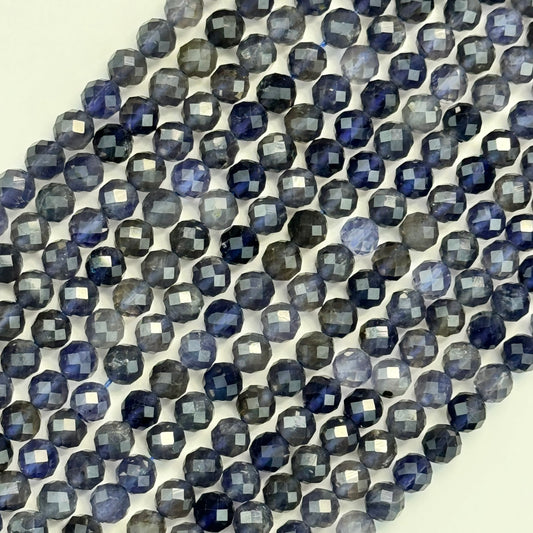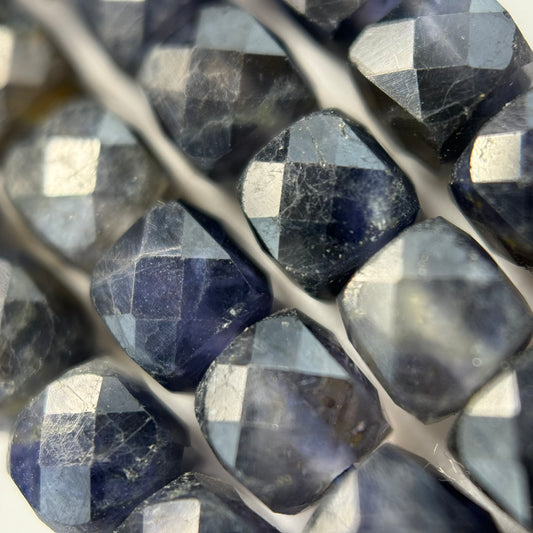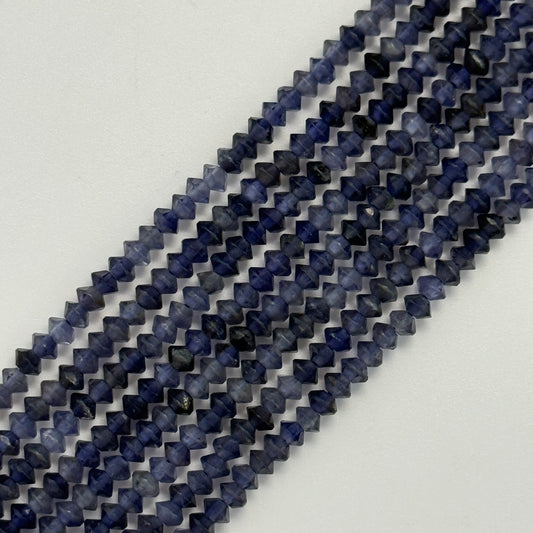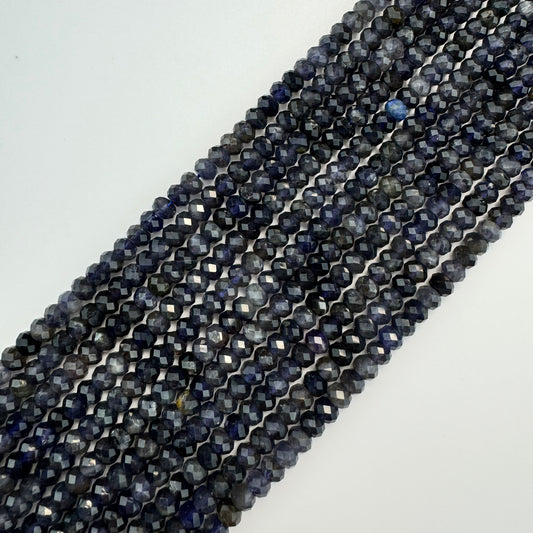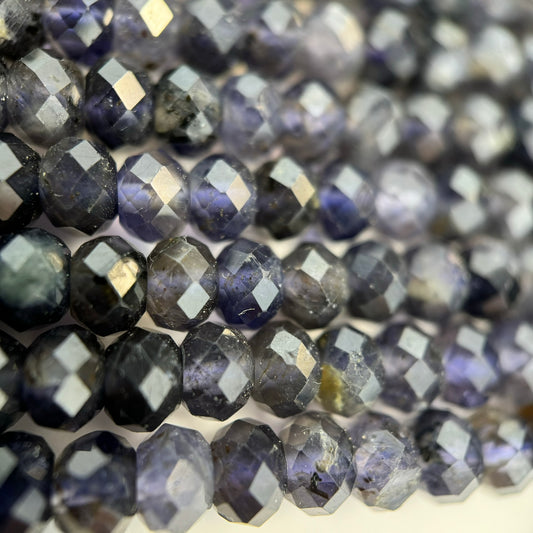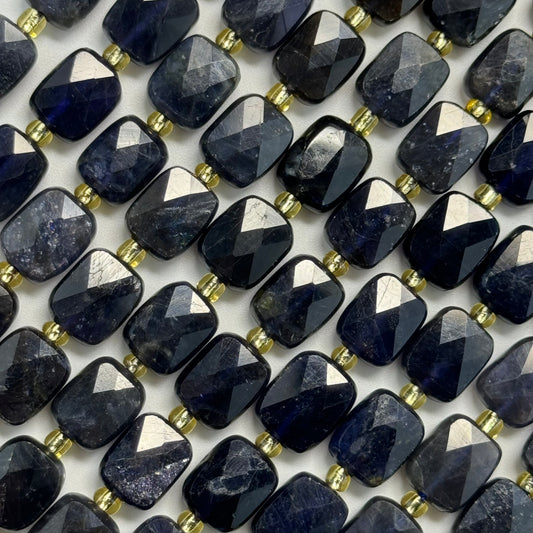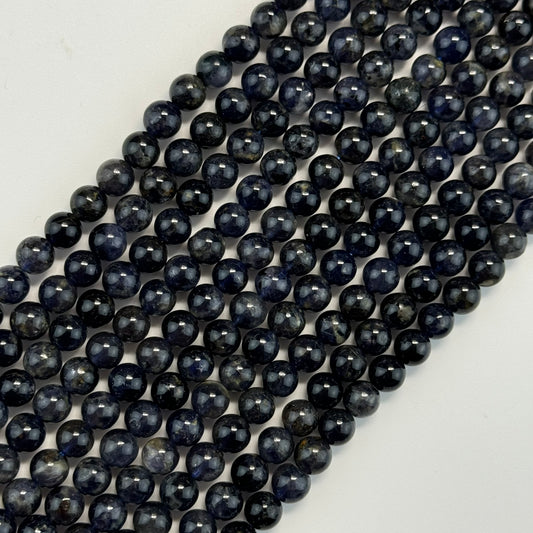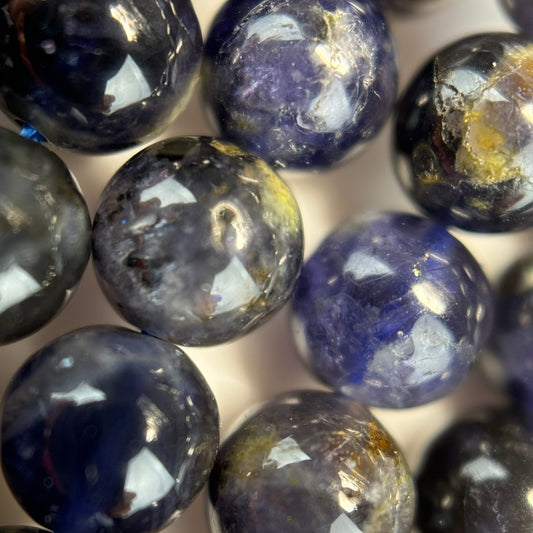Iolite Gemstone Beads
The Viking's Compass: The Story of Iolite Gemstone Beads
Imagine a gemstone so remarkable that ancient Viking navigators used it to find the sun on cloudy days, guiding their ships across treacherous seas when the sky offered no landmarks. This is iolite—a stone of navigation, both literal and spiritual. With its mesmerizing pleochroism that shifts from deep violet-blue to grayish-blue to pale yellow depending on the angle of light, iolite beads capture the very essence of change, clarity, and inner vision.
The name "iolite" comes from the Greek word "ios," meaning violet, perfectly describing its most prized color. But iolite is also known by another name that speaks to its legendary past: "Viking's Compass" or "Viking's Stone." This isn't just a poetic name—it's based on historical fact. Viking explorers discovered that by looking through a thin slice of iolite toward the sky, they could determine the position of the sun even when it was hidden behind clouds. This remarkable property, combined with the stone's beauty, made iolite a treasure both practical and mystical.
Today, jewelry makers and spiritual seekers are drawn to iolite beads not just for their stunning beauty, but for their profound metaphysical properties. As a stone of vision—both inner and outer—iolite helps wearers see truth clearly, navigate life's challenges, and connect with their intuition. Whether you're creating custom jewelry or seeking a talisman for guidance, iolite beads offer a unique combination of historical significance, natural beauty, and spiritual power.
Why Is It Named Iolite? The Science of Pleochroism
Iolite's name tells a story of color and discovery. Derived from the Greek word "ios" (violet), iolite perfectly describes the stone's most characteristic hue. But what makes iolite truly remarkable is its pleochroism—an optical phenomenon that makes the stone appear different colors when viewed from different angles.
When you hold an iolite bead and rotate it, you'll witness a magical transformation: from one angle, it appears a rich violet-blue (the color that gives it its name); from another, it shifts to a grayish-blue; and from a third angle, it reveals a pale yellow or almost colorless appearance. This remarkable property occurs because iolite (scientifically known as cordierite) has different light absorption properties along different crystal axes. Unlike other gemstones that maintain a consistent color, iolite's color literally changes before your eyes.
This pleochroism is what made iolite invaluable to Viking navigators. When polarized light from the sky passed through a thin slice of iolite, the stone's orientation could be adjusted to locate the sun's position—even when clouds obscured the view. Modern gemologists understand this phenomenon scientifically, but to ancient peoples, it seemed like magic—a stone that could see what the human eye could not.
In metaphysical traditions, this color-changing property symbolizes the ability to see situations from multiple perspectives, to shift viewpoints, and to gain clarity where others see only confusion. Iolite teaches that truth isn't always what it appears to be at first glance—sometimes you need to look from a different angle to see clearly.
The Ancient Origins: Where Iolite Comes From
The journey of iolite beads begins in the Earth's crust, where heat and pressure transform magnesium-aluminum silicate into the beautiful gemstone we know as iolite (cordierite). Iolite forms in metamorphic rocks, particularly those that have been subjected to high temperatures and pressures, often in association with other minerals like garnet, kyanite, and staurolite.
The finest iolites come from several premier locations around the world. India produces some of the most highly prized iolites, particularly from the states of Tamil Nadu and Karnataka. Indian iolites are renowned for their strong pleochroism and rich violet-blue colors. Sri Lanka (Ceylon) has been a source of fine iolite for centuries, producing stones with excellent clarity and color. Madagascar offers iolites with unique color variations, while Myanmar and Brazil also produce quality iolite specimens.
One of the most fascinating aspects of iolite mining is the challenge gem cutters face. Because of iolite's strong pleochroism, the orientation of the cut is crucial. A skilled cutter must position the stone so that the most desirable color (typically the rich violet-blue) is visible when the stone is set in jewelry. This requires expert knowledge of iolite's crystal structure and optical properties.
At Reza Gem Collection, certified gemologist Reza Piroznia carefully sources iolite beads from these premier locations, ensuring that each strand represents the highest quality available. With decades of expertise in gemstone authentication and quality assessment, Reza Gem Collection guarantees that customers receive authentic, untreated stones with the strongest pleochroic effects. Each iolite bead is selected not just for its beauty, but for its ability to display the full range of color-changing properties that make this stone so unique and valuable.
The Science Behind the Magic: Understanding Iolite
While iolite's name and legend suggest mystical origins, the science behind this remarkable gemstone is equally fascinating. Iolite is the gem variety of the mineral cordierite, named after French geologist Louis Cordier. Chemically, it's a magnesium iron aluminum cyclosilicate with the formula (Mg,Fe)₂Al₄Si₅O₁₈.
Iolite's signature pleochroism occurs because of its orthorhombic crystal structure and the way it absorbs light differently along its three crystal axes. When white light enters an iolite crystal, different wavelengths are absorbed depending on the direction of travel through the crystal. This creates the remarkable color-changing effect that makes iolite so distinctive.
The stone ranks 7 to 7.5 on the Mohs hardness scale, making it moderately hard and suitable for most jewelry applications. However, iolite has distinct cleavage in one direction, which means it can split along a plane if struck with sufficient force. This property requires careful handling during cutting and setting, but when properly worked, iolite creates stunning jewelry pieces.
Iolite's specific gravity ranges from 2.57 to 2.66, and it has a vitreous to greasy luster. The stone is typically transparent to translucent, with the best specimens being transparent and showing strong pleochroism. Natural iolite often contains inclusions, which can include apatite, zircon, or other minerals. These inclusions, when not excessive, don't necessarily detract from the stone's value—they can actually add character and prove the stone's natural origin.
One of the most interesting scientific aspects of iolite is its use in determining the grade of metamorphism in geological studies. Geologists use the presence and composition of cordierite to understand the temperature and pressure conditions under which rocks formed. This practical application, combined with its beauty, makes iolite a gemstone that bridges the worlds of science and aesthetics.
Healing Properties and Metaphysical Powers: The Stone of Inner Vision
The healing properties of iolite have been recognized for centuries, with traditions spanning from ancient navigation to modern crystal healing practices. As the "Viking's Compass," iolite is fundamentally a stone of guidance—but its guidance extends far beyond physical navigation to include spiritual direction, emotional clarity, and mental insight.
Third Eye Chakra and Spiritual Vision
Iolite is perhaps most strongly associated with the third eye chakra, the energy center located in the forehead that governs intuition, insight, and spiritual vision. This connection is no coincidence—just as iolite helped Vikings see the sun through clouds, it helps modern practitioners see truth through illusion, clarity through confusion, and guidance through uncertainty.
When working with iolite for third eye activation, many practitioners report enhanced psychic abilities, improved intuition, and clearer dreams. The stone is believed to open channels of perception that are normally closed, allowing access to higher wisdom and spiritual guidance. Those who practice meditation, divination, or astral projection often use iolite to enhance their abilities and deepen their spiritual practice.
The pleochroic nature of iolite—its ability to show different colors from different angles—symbolically represents the idea that truth has multiple facets. Iolite teaches that spiritual insight comes not from seeing things one way, but from being able to shift perspectives and see situations from multiple angles. This flexibility of perception is one of iolite's greatest gifts.
Emotional Healing and Clarity
Iolite is renowned for its ability to bring emotional clarity and help release patterns of self-deception. Many people struggle with seeing their own situations clearly—they may be stuck in relationships, careers, or life patterns that aren't serving them, but they can't see the truth because they're too close to the situation. Iolite is believed to provide the "distance" needed to see clearly, much like how it helped Vikings see the sun despite clouds.
For those dealing with confusion, indecision, or emotional overwhelm, iolite offers clarity and direction. It's particularly helpful during times of transition when the path forward isn't clear. The stone is believed to help quiet mental chatter and emotional noise, allowing the inner voice of wisdom to be heard.
Iolite is also associated with releasing addictions and unhealthy patterns. Its ability to "see through" illusions makes it powerful for recognizing self-destructive behaviors and finding the strength to change them. Many people use iolite when working through recovery, whether from substance abuse, codependency, or other addictive patterns.
Physical Healing Properties
In crystal healing traditions, iolite is associated with several physical healing properties, though these should always be considered complementary to professional medical care, not replacements for it.
Eye Health: Given iolite's association with vision (both literal and metaphorical), it's often used for eye-related issues. Some practitioners believe iolite can help with eye strain, vision problems, and headaches related to eye fatigue. The stone's connection to the third eye chakra also relates to the physical eyes, as these energy centers are closely linked.
Liver and Detoxification: Iolite is believed to support liver function and assist with detoxification processes. This association may relate to the stone's ability to help "filter" and clarify, both energetically and physically. Some practitioners use iolite for supporting the body's natural detoxification systems.
Headaches and Migraines: Because of iolite's connection to the third eye and its calming properties, it's sometimes used for headache and migraine relief. The stone is believed to help balance energy in the head region and reduce tension that can contribute to headaches.
Sleep and Dreams: Iolite's connection to inner vision extends to the dream realm. Many practitioners use iolite to enhance dream recall, promote lucid dreaming, and improve sleep quality. The stone is believed to help bridge the conscious and subconscious minds, allowing for clearer communication through dreams.
Mental Clarity and Focus
Iolite is often called the "stone of clarity" because of its ability to cut through mental fog and confusion. For those who struggle with scattered thoughts, difficulty concentrating, or mental overwhelm, iolite offers focus and direction. It's particularly helpful for students, researchers, and anyone who needs to process complex information.
The stone is believed to enhance memory and learning ability, making it useful for academic pursuits or skill development. Its association with navigation—both physical and mental—makes it powerful for finding your way through complex problems or projects.
For those dealing with decision-making challenges, iolite provides the clarity needed to see options clearly and choose the best path forward. The stone's pleochroism—showing different aspects from different angles—symbolically represents the ability to consider multiple perspectives before making decisions.
Spiritual Growth and Transformation
Iolite is a powerful stone for spiritual growth and transformation. Its ability to reveal hidden truths makes it valuable for shadow work—the process of acknowledging and integrating the parts of ourselves we'd rather not see. Just as iolite helped Vikings see the sun through clouds, it helps spiritual seekers see their own truth through layers of conditioning, fear, and illusion.
The stone is associated with past-life work and karmic healing. Some practitioners believe iolite can help access past-life memories and understand current life patterns that stem from previous experiences. This makes it valuable for karmic healing and breaking cycles that span multiple lifetimes.
Iolite is also connected to astral travel and out-of-body experiences. Its ability to help "navigate" non-physical realms makes it a favorite among those who practice astral projection or shamanic journeying. The stone is believed to provide protection and guidance when exploring spiritual dimensions.
Using Iolite for Specific Intentions
Different ways to work with iolite for specific purposes:
- For Clarity: Hold iolite during meditation, focusing on the area you need clarity about. Allow the stone's energy to help you see the situation from multiple angles.
- For Intuition: Wear iolite jewelry near the third eye (forehead) or place it on your third eye chakra during meditation to enhance intuitive abilities.
- For Decision-Making: Carry iolite when facing important decisions. Use it to help see all options clearly and choose the best path.
- For Emotional Healing: Place iolite over the heart chakra to help release emotional patterns and see relationships clearly.
- For Spiritual Vision: Use iolite during divination practices, dream work, or astral travel to enhance your ability to see beyond the physical realm.
Iolite Gemstone Beads in Jewelry Making
Iolite beads offer jewelry makers unique opportunities to create pieces that are both beautiful and meaningful. The stone's pleochroic properties create dynamic, ever-changing displays of color that make each piece unique. Whether you're crafting spiritual jewelry, custom designs, or everyday accessories, iolite brings distinctive beauty and powerful symbolism to every creation.
- Perfect for making iolite necklaces, bracelets, and pendants
- Available in smooth round, faceted, cabochon, and raw bead styles
- Pairs beautifully with silver, gold, or complementary gemstones like amethyst and sapphire
- Ideal for spiritual, custom, and metaphysical jewelry pieces
- Trusted by jewelers and designers for their unique pleochroic properties and natural quality
Iolite Beaded Jewelry
Iolite beaded jewelry combines the mystical beauty of this gemstone with the artistry of handcrafted design. Known for its unique pleochroic properties and symbolic meaning, iolite beads are widely used in necklaces, bracelets, earrings, and pendants. Whether you're looking to create a spiritual piece or a modern everyday accessory, iolite beads offer versatility and enchanting beauty that changes with movement and light.
Iolite Beaded Necklaces
Iolite bead necklaces make a striking impression, whether strung alone or paired with silver, gold, or complementary gemstones. The pleochroic effect creates dynamic color displays as the necklace moves, shifting from violet-blue to grayish-blue to pale yellow. Many wearers choose iolite necklaces as talismans for clarity and guidance, particularly during times of transition or decision-making. The stone's association with the third eye makes it powerful when worn near the throat or heart chakras.
Iolite Beaded Bracelets
Iolite bracelets, often made with faceted, round, or cabochon beads, are perfect for everyday wear or special occasions. The pleochroic effect is particularly noticeable in bracelets, where movement creates constant color shifts. Many practitioners wear iolite bracelets during meditation, spiritual work, or when they need mental clarity. The stone's moderate hardness makes it suitable for daily wear when properly set and cared for.
To find your Beaded Bracelets click here visit this page
Iolite Beaded Earrings
Iolite earrings crafted with gemstone beads showcase the stone's pleochroism beautifully, as movement creates dynamic color displays. Whether in drop, stud, or dangle styles, iolite earrings bring unique beauty and spiritual meaning to any outfit. The stone's connection to the third eye makes earrings particularly powerful, as they frame the face and the third eye chakra area.
Iolite Beaded Pendants
Iolite pendants made from gemstone beads highlight the stone's unique pleochroic beauty in a focused, elegant way. Whether wire-wrapped, bezel-set, or strung on fine chains, iolite pendants serve as powerful talismans for clarity, intuition, and spiritual guidance. Many people choose iolite pendants as daily reminders to see truth clearly and trust their inner vision, making them popular as spiritual tools and meaningful gifts.
Finding the Highest Quality Iolite Beads: Why Reza Gem Collection?
Not all iolite beads are created equal. The quality of these gemstones depends on origin, pleochroism strength, color intensity, clarity, and authenticity. At Reza Gem Collection, certified gemologist Reza Piroznia brings decades of expertise to sourcing and authenticating these remarkable stones.
What sets Reza Gem Collection apart is their commitment to quality and authenticity. Every iolite bead is carefully examined for:
- Pleochroism Strength: Iolites are selected for strong, visible pleochroism—the signature color-changing effect that makes these stones magical. The best iolites show distinct color changes from violet-blue to grayish-blue to pale yellow.
- Color Quality: Rich violet-blue is the most prized color in iolite. Reza Gem Collection selects stones with intense, saturated colors that display the full range of pleochroic effects.
- Origin Verification: Reza Gem Collection sources directly from premier locations—Indian iolites with exceptional pleochroism, Sri Lankan stones with excellent clarity, and other verified high-quality sources.
- Natural and Untreated: All stones are verified as natural and untreated, ensuring that customers receive authentic gemstones with genuine metaphysical properties and natural beauty.
- Cutting Expertise: Iolite requires skilled cutting to maximize pleochroic display. Reza Gem Collection works with expert cutters who understand how to orient iolite to show its best colors.
- Consistency: Beads are matched for consistent color, size, and pleochroic effects, creating uniform strands perfect for jewelry making.
- Expert Authentication: As a certified gemologist, Reza Piroznia personally verifies each stone, providing peace of mind that cannot be matched by mass-market suppliers.
When you purchase iolite beads from Reza Gem Collection, you're not just buying gemstones—you're investing in pieces that have been carefully selected for their beauty, authenticity, and energetic properties. Whether you're a professional jewelry maker, a spiritual practitioner, or someone seeking the perfect gemstone for personal use, Reza Gem Collection ensures that you receive the highest quality stones available, with the strong pleochroic effects that make iolite so special.
Iolite Gemstone Price, Value, and Cost
The price of iolite gemstones can vary significantly based on origin, pleochroism strength, color intensity, clarity, and cut quality. While generally more affordable than precious stones like sapphire (which iolite can resemble), high-quality pieces with strong pleochroism command premium prices.
- Natural, untreated iolites from India with strong pleochroism and rich violet-blue colors are the most expensive and highly sought after, especially in larger sizes with exceptional optical effects.
- Sri Lankan iolites with excellent clarity and strong pleochroism are valued for their transparency and color quality, often commanding higher prices.
- Iolite beads for jewelry making can range from $15 to $200 per strand depending on quality, pleochroism strength, color intensity, cut, and origin. Premium strands with exceptional pleochroic effects can exceed $300.
- Lab-created or synthetic versions cost significantly less but lack the natural pleochroic phenomena and don't hold the same value as natural stones. More importantly, synthetic stones don't carry the same metaphysical properties that make natural iolite so valued.
When evaluating iolite gemstone value, consider not just price per strand, but also the strength of pleochroism (the ability to show distinct color changes), color intensity (rich violet-blue is most valued), authenticity, and the overall appeal of the stones. Always buy from trusted sources, ideally with certification from a gemologist like Reza Piroznia at Reza Gem Collection, to ensure quality and transparency. Remember: with gemstones, you're not just buying a product—you're investing in a piece of Earth's history, imbued with natural beauty, remarkable optical properties, and energetic qualities that synthetic stones simply cannot replicate. Iolite's unique pleochroism and historical significance as the "Viking's Compass" make it a gemstone that offers both aesthetic beauty and profound meaning.
Frequently Asked Questions
What are iolite gemstone beads?
Iolite gemstone beads are small, cut pieces of natural iolite (cordierite) used in making jewelry like necklaces, bracelets, and earrings. Iolite displays a beautiful pleochroism, showing different colors when viewed from different angles.
How can you tell if iolite beads are real?
Genuine iolite beads show strong pleochroism—appearing violet-blue from one angle, grayish-blue from another, and pale yellow from a third angle. Real iolite also has a vitreous luster and natural inclusions, while synthetic versions lack the distinctive color-changing properties.
What is the origin of most natural iolite gemstones?
Most natural iolites come from India, Sri Lanka, Madagascar, Myanmar, and Brazil. Indian iolites are particularly prized for their strong pleochroism and rich violet-blue colors.
What are the benefits of using iolite beads in jewelry?
Iolite beads add unique color-changing beauty and are believed to enhance intuition, clarity, and spiritual vision. They're known as the "Viking's Compass" stone for their navigation properties.
How are iolite beads made and cut?
Iolite beads are cut from larger crystals, shaped into rounds, faceted forms, or cabochons, and polished to showcase their pleochroic properties. Careful cutting is essential to maximize the color-changing effect.
What is the meaning and symbolism of iolite gemstones?
Iolite symbolizes clarity, intuition, and inner vision. Known as the "Viking's Compass," it represents guidance, direction, and the ability to see truth clearly.
How do you care for and clean iolite gemstone beads?
Clean iolite beads with warm soapy water and a soft cloth; avoid harsh chemicals, ultrasonic cleaners, and prolonged exposure to direct sunlight or extreme temperatures.
What is the price range for natural iolite beads?
Natural iolite beads typically range from $15 to $200 per strand depending on quality, pleochroism strength, color intensity, cut, and origin.
How do iolite beads compare to other gemstone beads?
Iolite beads offer unique pleochroic properties that set them apart from other gemstones. They're moderately hard (7-7.5 on Mohs scale) and less expensive than sapphire but offer similar blue-violet beauty.
Are iolite beads suitable for everyday jewelry?
Yes, iolite beads are durable enough for everyday wear when properly set and cared for. Their moderate hardness makes them suitable for most jewelry applications.
What are the different shapes and cuts available for iolite beads?
Common shapes include round, faceted, oval, cabochon, rondelle, and freeform cuts. Faceted cuts best showcase iolite's pleochroism, creating dynamic color displays.
How can I tell the quality of an iolite bead?
Quality is based on the strength of pleochroism, color intensity (rich violet-blue is most valued), clarity, consistency, and minimal visible cracks or inclusions.
What is the difference between treated and untreated iolite beads?
Most iolite beads are untreated and natural. Some may receive heat treatment to enhance color, but natural, untreated iolites with strong pleochroism are most valuable.
Can iolite beads be used in spiritual or healing jewelry?
Yes, iolite is often used for enhancing intuition, clarity of thought, and connecting with inner vision. It's particularly valued for third eye chakra work and spiritual guidance.
What metals pair best with iolite gemstone beads?
Silver, white gold, and platinum beautifully complement iolite's cool violet-blue tones, while yellow gold creates an elegant contrast. Iolite pairs well with complementary gemstones like amethyst or sapphire.
How do I design a necklace or bracelet with iolite beads?
Use iolite beads as focal points or accents, combining them with complementary gemstones like amethyst, clear quartz, or silver spacers. The pleochroic effect creates visual interest as pieces move.
Are there any famous jewelry pieces featuring iolite beads?
Iolite has been used in vintage and contemporary jewelry designs, though it's less common than popular gemstones. Its unique pleochroism makes it a favorite among designers seeking distinctive pieces.
What is the historical significance of iolite in jewelry?
Iolite was used by Vikings as a navigation tool (Viking's Compass) to locate the sun on cloudy days. It has been treasured for centuries for its color-changing properties and spiritual associations.
How do I store iolite beads to prevent damage?
Store iolite beads separately in a soft pouch or lined box away from harder gemstones to prevent scratches, and avoid exposure to heat, chemicals, or direct sunlight.
Where can I buy authentic iolite gemstone beads?
Buy from reputable gem dealers like Reza Gem Collection, where certified gemologists verify authenticity, quality, and the strength of pleochroic effects in iolite beads.
